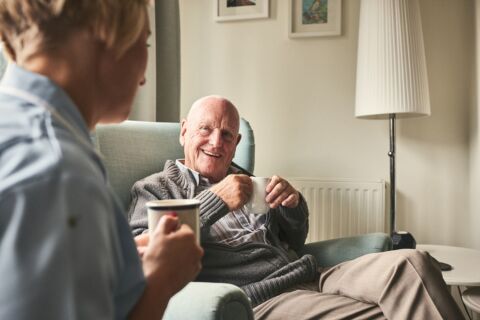Families and hospitals want the same thing: reduce hospital readmissions by keeping people safe at home with the right help at the right time. This article sets out a practical care framework to cut avoidable hospital readmissions, improve client safety, and deliver better client outcomes through flexible, high-touch, personalised home care.
We’re set up to provide intense transitional care in the days after hospital discharge, then taper services as recovery builds. If health needs rise, we can increase support again at any time, fully flexible and responsive.
TL;DR
- The goal is to reduce avoidable 28-day readmissions by keeping people safe at home with proactive, high-touch, personalised transitional care after discharge.
- Readmissions may happen due to clinical drivers (heart failure, COPD, AMI, frailty) plus non-clinical gaps (poor handover, missed medication reconciliation, weak social support, limited outpatient access).
- Acquaint's care offers an intensive start, then taper, RN visit within 24–48h, daily check-ins, therapy support and transport, scaling up again quickly if needs rise; strong continuity of care and clear family updates.
- A framework may include pre-discharge risk flagging and a 7-day plan; comprehensive med reconciliation and community supply; Weeks 2–6 adaptive reviews with the same trusted team to lock in gains and prevent bounce-backs.
- Families benefit from fewer emergency returns, steadier recovery, RN-led plans, dependable arrivals, and a familiar team that knows the person, their story and goals.
What is hospital readmission?
A hospital readmission is when someone returns to acute care soon after leaving. In Australia, health systems track 28 day readmission rates. Some readmissions are unavoidable, but a significant share are preventable readmissions linked to gaps in the discharge process, missed medication reconciliation, poor handovers to primary care providers, limited client education, or lack of continuity of care in outpatient settings. Reducing unplanned readmissions matters because they carry a substantial financial burden for healthcare facilities, strain healthcare systems, and, most importantly, affect quality of life.
Why avoidable readmissions happen?
Common clinical drivers
- Heart failure / congestive heart failure: fluid management issues, diet, early symptom drift, and complex medicines.
- Chronic obstructive pulmonary disease: breathlessness, infections, inhaler technique, oxygen use.
- Acute myocardial infarction: medication adherence, cardiac rehab access, early red flags.
- Frailty in older adults and elderly clients: falls, delirium risk, nutrition, and polypharmacy.
Non-clinical drivers
- Poor social support after discharge, no one to help with meals, medicines, or transport.
- Fragmented care coordination across healthcare facilities and primary care.
- Limited access to outpatient care (GP appointments, community nursing, physical therapy).
- Missed early warnings because no one is checking in.
Our promise: proactive, personalised, flexible
- Intense start, then taper: Right after hospital discharge, we provide concentrated help: daily care, support for therapy programs, and check-ins. As strength returns, we can decrease services. If health needs change, we can scale back up quickly.
- Continuity of care: Familiar faces build trust and pick up subtle changes faster.
- Clear updates: Families receive timely reports on progress, risks, and next steps.
- Premium standards: Registered Nurse (RN) oversight, clear protocols, and a responsive care line.
A practical care framework to reduce hospital readmissions
Below is the care framework we use to reduce readmissions and drive better client outcomes.
Handover that closes every loop (Day −1 to Day 0)
Identify clients at risk before discharge:
- High risk clients and high risk client groups flagged by client demographics, diagnosis (e.g., heart failure, chronic obstructive pulmonary disease, acute myocardial infarction), number of medicines, cognition, frailty, and risk adjustment scores.
- Confirm supports at home; surface gaps in outpatient care and transport.
Comprehensive discharge planning:
- Align goals across hospital medical teams, ward nurses, allied health, and family.
- Produce a simple plan for the first 7 days: visits, calls, physical therapy, wound care, diet, and red flags.
- Start advanced care planning conversations where appropriate, including escalation preferences and contacts.
Medication reconciliation:
- Compare admission, inpatient, and discharge lists. Remove duplicates, stop non-essential items, and confirm community supply.
- Provide schedules and blister packs for medication where required. This single step is often the hinge that helps reduce hospital readmissions.
The first 72 hours at home: high-touch transitional care
- Small handpicked care team in place, in attendance for as little as 3 hours or up to 24 hour care.
- RN visit within 24 - 48 hours: check vitals, symptoms, wound sites, and medicines; confirm follow-ups; scan the home for fall risks.
- Care coordination with primary care providers: ensure GP / clinic appointments are booked.
- Daily transitional care services calls: spot issues before they escalate: breathlessness, weight gain, fever, confusion.
- Arrange outpatient settings rehab (physical therapy) where indicated.
- Transport to primary care and specialist visits as needed.
Weeks 2–6: taper or intensify based on need
- Reduce visit frequency as goals are met. If warning signs return, increase quickly, our service is fully flexible by design.
- Keep continuity of care with the same trusted team.
- Update the plan after each review to lock in gains and prevent unplanned readmissions.
Working with hospitals and primary care providers
We partner with hospital medical teams to reduce hospital readmissions:
- Hospital strategies: flag clients at admission; start discharge planning early; schedule GP follow-up before leaving hospital.
- Outpatient care links: we can get you to cardiac rehab, pulmonary rehab, and allied health appointments.
Why flexible intensity matters
Recovery is not linear. Some days are tougher than others and older people typically take longer to recover from surgery or a major illness. Our approach is simple: provide intense help until the person is steady on their feet; taper services to build independence; then raise support again if there’s a wobble. This fluid model keeps people safe without locking them into the wrong level of care.
What families can expect from our premium service
- Same dedicated carers wherever possible to maintain continuity of care.
- Clear start times; dependable arrivals.
- RN-led care plans, regular reviews, and accessible contacts for questions.
- Thoughtful updates so families always know what’s happening.
- Respect for preferences and routines at home.
What success looks like for families
- Fewer frantic dashes back to hospital.
- Clear answers, not confusion.
- A familiar team who knows the person, their story, and their goals.
- A home that feels safe again.
Let's reduce hospital readmissions
If you’re looking for a premium, flexible service that prevents avoidable hospital readmissions and supports safer recovery at home, we’re ready to help. Book a no-obligation home care consult today. When you’ve decided to engage our services, we’ll then build a personalised plan, provide the right level of help from day one, and adjust up or down as needs change, so you can feel confident your loved one is safe, comfortable, and cared for.
FAQs about hospital readmissions
What is hospital readmission?
Hospital readmission is a return to acute care within 28 days after leaving the hospital. Some readmissions are expected; the focus is on preventable readmissions.
What are the causes of hospital readmission?
The causes of hospital readmissions include condition flare-ups (e.g., congestive heart failure, chronic obstructive pulmonary disease), medicine errors, infections, missed appointments, and poor social support. Gaps in the discharge process and weak care coordination are frequent contributors.
Does home care really reduce readmissions?
Home care on its own is not a magic fix for reducing readmissions, but when it wraps around discharge, works closely with the GP, focuses on wellness, reablement, identification early warning signs, and keeps continuity of care, it reduces risk for many people. That’s what our model is built to do.
Last updated: September 2025
You might also like

How to take care of a person with dementia
How can I give them the best support without giving up everything else in my life?

Private palliative care Melbourne
Comfort, choice, and calm routines